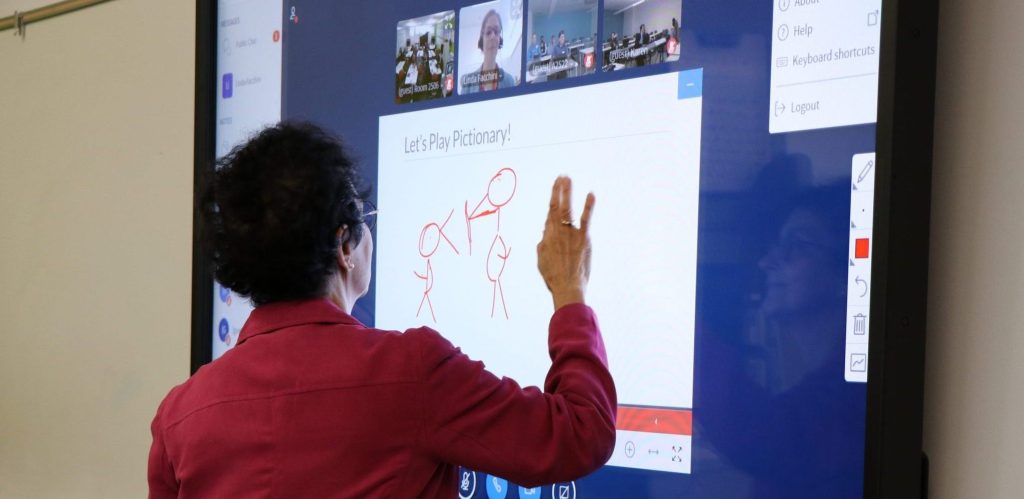Module 4: The Virtual Classroom as a Learning Community
Harnessing Technology for Engagement & Communication
When you’re creating an online course, you’ll undoubtedly utilize tools in some form or another. Be it a piece of software, a website, something integrated into the Learning Management System (LMS), or even the LMS itself. Generally speaking, tools are things that we can use to perform specific functions. But in the context of online learning, tools are also things that help facilitate communication and engagement.

Source: “An instructor in a HyFlex classroom promoting student engagement” by Seneca College, The Teaching & Learning Centre, Oct 2019, CC BY-NC-SA
Tool Dreamin’
Tools can often be the most exciting part of course design and functionality: they’re slick, pretty, colourful, and they can help you pull off a lot of fancy stuff. Picking the right tool for the right job means you aren’t overwhelming learners and that, above all else, your chosen tool is servicing the goals and outcomes of your course. Photoshop is a powerful tool, but might not be especially useful in getting students to engage with the material or each other. Tools that will help with this are likely to fashion new spaces for conversation, collect lots of inputs, allow learners to express themselves, and present new lenses through which they can work through content and material.
Making sure a specific tool fits your course’s wants and needs can sometimes prove tricky. You might want to make use of a formal assessment rubric [PDF] to compare tools, or evaluate one tool in particular. In some cases your institution (like Seneca) might already maintain and keep tabs on a list of pre-approved tools. Selecting tools from such a list will ensure that you have at least some level of institutional support, and that it ought to work within your LMS.
Explore
Below you’ll find a small presentation showcasing a few tools we think you might find to be useful.
In the interactive element below, use the menu bar (☰) on the left or the arrows on the right to view the contents on all pages (6).
Tip: If you’re partial to rolling up your sleeves and digging around on your own, visit the eCampus resource list, part of their Ontario Extend program.
Measure Twice, Cut Once
After deciding on what tools you’d like to take advantage of, you’ll want to plan some time to experiment with them yourself and figure out some of the nuances or challenges associated with their use.
Unlike factors such as cost, accessibility, and data privacy, it’s sometimes hard to gauge just how well a tool will lend itself to the course material (or the LMS). Something might seem like a dream on paper, but a nightmare to deploy in the way you had envisioned. If you find yourself wondering whether or not the tool adds or takes away from the learning experience, ask yourself:
- Does this tool serve the goals and objectives of the course?
- Does this tool make things more or less accessible for my learners?
- Will the tool increase expression (with other learners, with the content itself)?
Remember that tools exist to serve the ends of our learning community, not the other way around. If they don’t make our lives easier, or offer new opportunities, you might want to rethink that tool’s inclusion. You’ll have to experiment and play around a little to find what fits, but by keeping your learning goals and outcomes front of mind, you should be able to select the right tools for the right jobs in your course to enrich your learners.
Activity: All Together Now!
Consider what we’ve learned so far with TRIZ regarding communication and community. By identifying what we don’t want, we learn what we do want. And by learning what we want, we can identify what we need. With the presumed ethos of your would-be course in mind, think of a tool that will help serve those ideas and evaluate it with some of the aforementioned methods.
If you’re thinking about a tool from the showcase above, you can ask yourself the three bulleted questions previously outlined (will the tool serve us, will the tool improve ease and accessibility, will the tool increase expression). If you’re thinking about a different tool, try to size it up using Western University’s eLearning Tool rubric[PDF]. You can even mix and match approaches, or make use of TRIZ again (how can I make sure this tool makes my course worse?)
Looking Back and Moving Forward
Hopefully by now you have a firm understanding of the ways in which you can turn your course into more of a community. Through the action of co-creation and communication, you’ll be able to intrinsically motivate your learners and help fashion a space that encourages meaningful relationships and, of course, learning! As well, you know what to look for in tools that will help you establish and facilitate that action and atmosphere.
The next section of this module deals with the Community of Inquiry framework (Garrison, et al., 1999).[1] We’ll be exploring the ways in which different forms of presence converge to produce a valuable learning experience. We will take what we’ve learned about communication and community, and apply it to other forms of interaction that will occur within your course.
Key Takeaways
Tools are meant to work in service of your course’s goals and outcomes, not the other way around.
You should look to select tools that improve accessibility, or improve the course’s ability to facilitate itself as a learning community.
Part of tool selection is about curation and experimentation — taking the time to understand the idiosyncrasies of your chosen software.
Just because a tool looks slick, doesn’t mean it’ll work well or necessarily meet the needs of your course.
- Garrison, D. R., Anderson, T., & Archer, W. (1999). Critical inquiry in a text-based environment: Computer conferencing in higher education. The Internet and Higher Education, 2(2-3), 87–105. https://doi.org/10.1016/s1096-7516(00)00016-6 ↵

